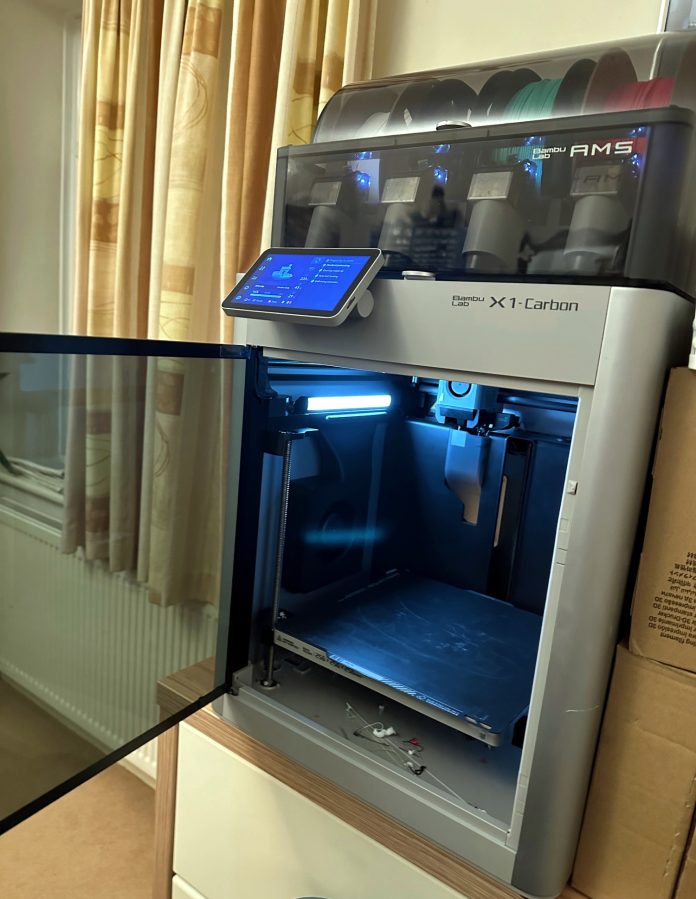What are 3D printers?
3D printers are a piece of technological equipment that can print three-dimensional objects. There are several suppliers that manufacture 3D printing products for home use. 3D printers are usually about the size of a traditional 2D paper printer and are designed to sit on top of a table or workbench. Larger printers for commercial use are also common.
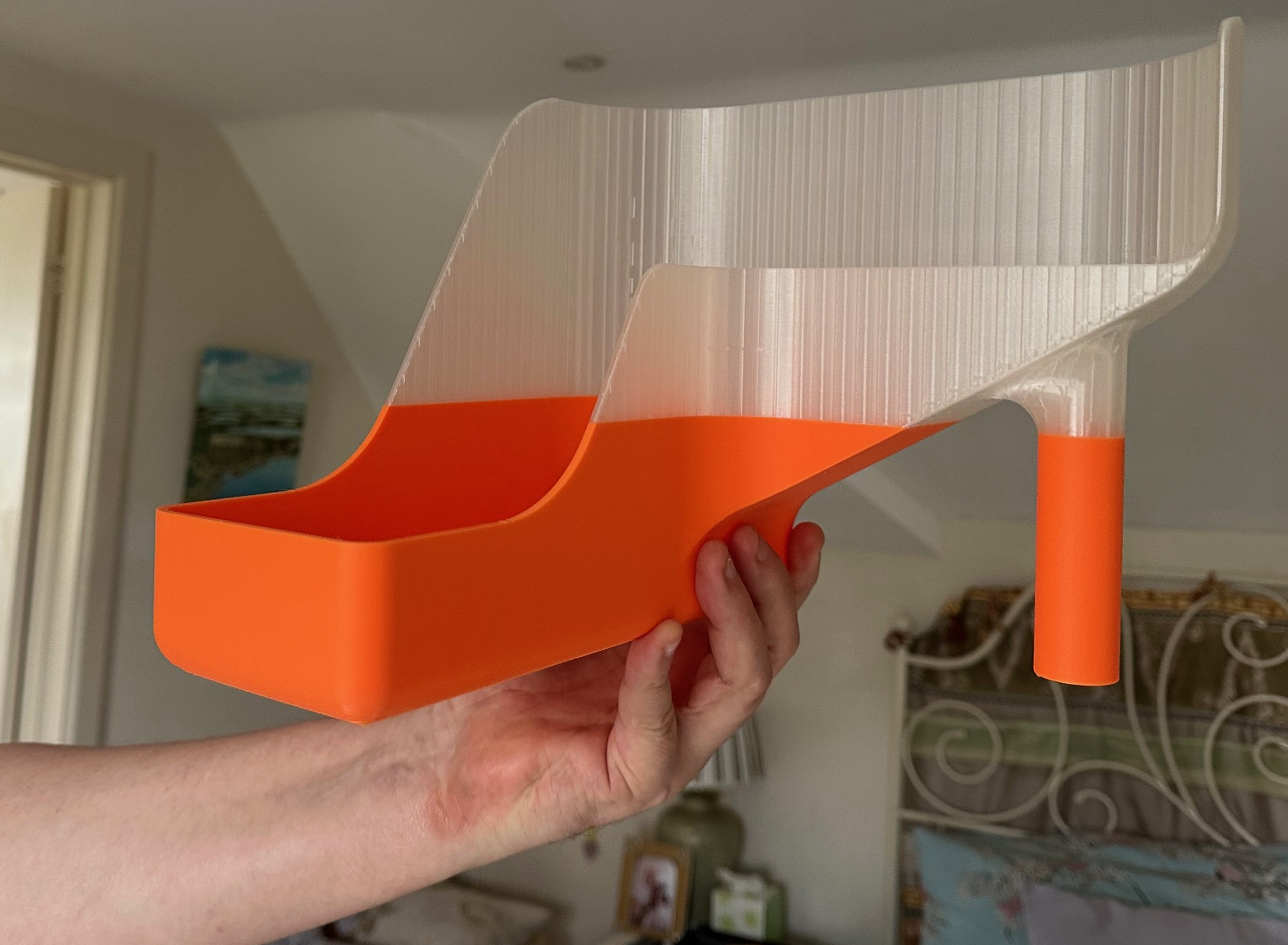
Photo by A. Howse
Which types of 3D printers are available?
Most common type of 3D printers are the Fused Deposition Modeling (FDM) types. FDM 3D printers extrude filament onto a bed and build the object as layers. Other types of 3D printers are resin and also metal printers.
Resin printers work by using light at specific light frequency (405Nm) to solidify the resin. Resin printers gives the highest quality results but as it is resin, it has some environmental and toxicity considerations so they are generally only chosen if a custom built studio lab area can be specifically designed to overcome these drawbacks.
Metal printers work by using a laser to heat up a metal powder which then solidify. Metal printers are currently very expensive and cost from £400,000 and upwards so are not usually used in a domestic setting.
How do 3D printers know what to print?
Usually, a design is created by a 3D printer user or designer with specialist Computer Aided Design CAD software on their device or PC. One professional software choice is AutoDesk Fusion 360 or Autodesk also make Tinkercad which is a perfect program for beginners to CAD of all ages. (7) (8)
After the design is created it has to be converted into a language that the 3D printer understands. Software for converting the 3D CAD design into the printer language is called a “slicer”. It basically analyses the 3D object and based on the settings of the software, it will convert the 3D model into a script that the 3D printer can process. It is possible to make a specific design from scratch that will suit almost all requirements.
3D Designs that have already been created are often saved to a design library so other 3D printer users can also use them easily, a bit like making a new sewing pattern and then sharing it online.
The new or the carefully selected pre-existing 3D design is then downloaded to the user’s device. Then the 3D design is then uploaded or ‘sent’ to the 3D printer, usually using internet wi-fi, although some printers will conveniently pass on the digital design information using a computer cable or SD card.
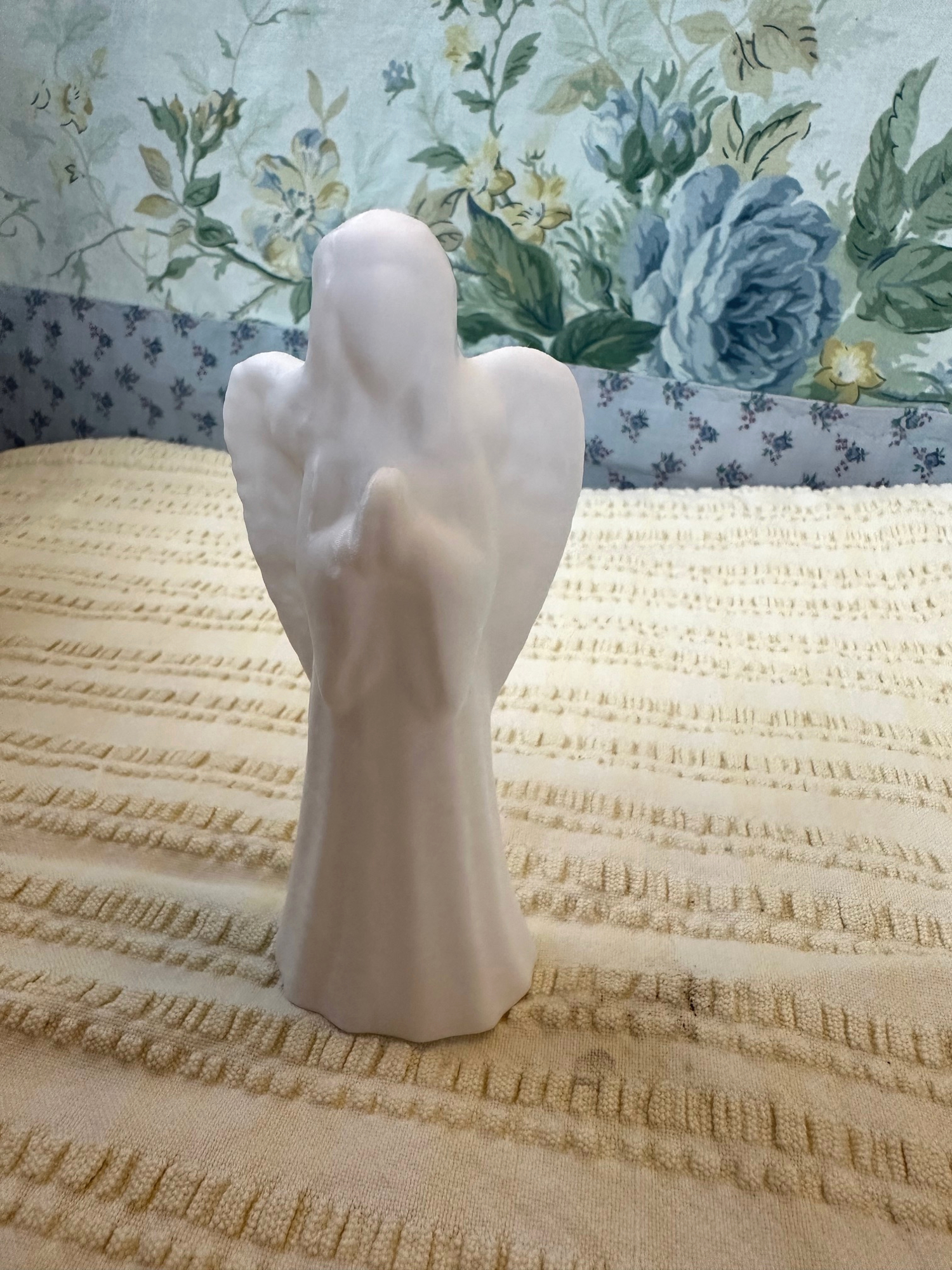
Photo by A. Howse
How do 3D printers work?
The printers use filament which is stored on reels rather like storing old fashioned rope or haberdashery trimmings. Arms or rollers move a print head according to digital instructions received by the unit.
Depending on the type of 3D printer, either the base of the unit stays in situ and the guides and rollers move the printer head as required through the x, y and z axis (horizontal, vertical and the perpendicular orthogonal or depth axis) or the print head stays put in the Y axis and the bed is moved by the machine as required.
The string like filament liquifies when heated by the print head and then the extruded material quickly sets into a solid state again where it is immediately cooled by fans on the print head. The item is printed onto a plate or ‘bed’ of the printer at the base of the printer.
The printed object is created by building up many fine horizontal layers much like a traditional ceramic coil pot or a layer cake. Typically, these layers are 0.2mm high. You can change the “layer height” to get either a faster print and a bit less quality or even a lower resolution, which gives a much finer result but the time it takes will increase accordingly.
The latest 3D printers are able to store different coloured reels in a storage rack usually on top of the printer. This enables multi-coloured prints featuring amazing levels of detail, printed text and decoration.
Commonly used filament such as PLA (polylactic acid) and ABS (acrylonitrile styrene) is affordable for beginners and available in an impressive array of hues and finishes from most manufacturers and a whole host of 3D printing accessory suppliers.
Why would you want a 3D printer and who are they for?
3D printers can be used to make things at home for personal use such as personalized presents for loved ones. 3D printers are brilliant for fixing and making new parts for broken appliances and creating useful objects for using around the home. 3D printers are ideal for making holiday decorations and crafting accessories. These modern printers are perfect for both hobbyists and engineers and everyone in between.
The process of 3D printing uses a lot of different skills such as creativity and problem solving as well and technical skills and so 3D printers can be a fun way to provide an educational activity for the whole family. Schools, collages and universities often include 3D printing projects into their teaching programs and developing products for 3D printing can be a practical team activity, that helps to develop soft skills such as communication too.
3D printers are very common in industrial and commercial settings and can come in a variety of sizes, scales and types. Larger printers can print using strong metal alloy materials. 3D printers can produce moulds which then can be used to make a range of different products for domestic and commercial use.
Small business owners who are proficient in 3D printing often develop a niche product range of 3D printed products which they can sell online via their own websites and also on larger sites such as eBay or Etsy. Some creatives make things to sell which then can help pay for adding to their studio and updating their range of printers over time.
3D printing is not considered an expensive activity for the hours of fun that can be had creating an unlimited possibility of items, a roll of 3D printer filament is typically 10 Pounds and upwards for 1 Kg. Second hand printers start at around £50 on sites like eBay and the latest 3D printers can be £100 upwards.
However cheaper 3D printers have a tendency to require a lot of tinkering and therefore a lot of time is spent on getting the desired quality of prints. Quality printers usually cost from £400 and upwards. Buying cheap usually means a lot of time (and filament!) is wasted so opting for an inexpensive printer at the start of a new 3D printing hobby is usually a false economy.
One advantage of this type of machine is that many accessories can be printed by the printer itself. Usually there are several clever people who have already created free designs for the most useful printer accessories to help any printer run smoothly and efficiently.
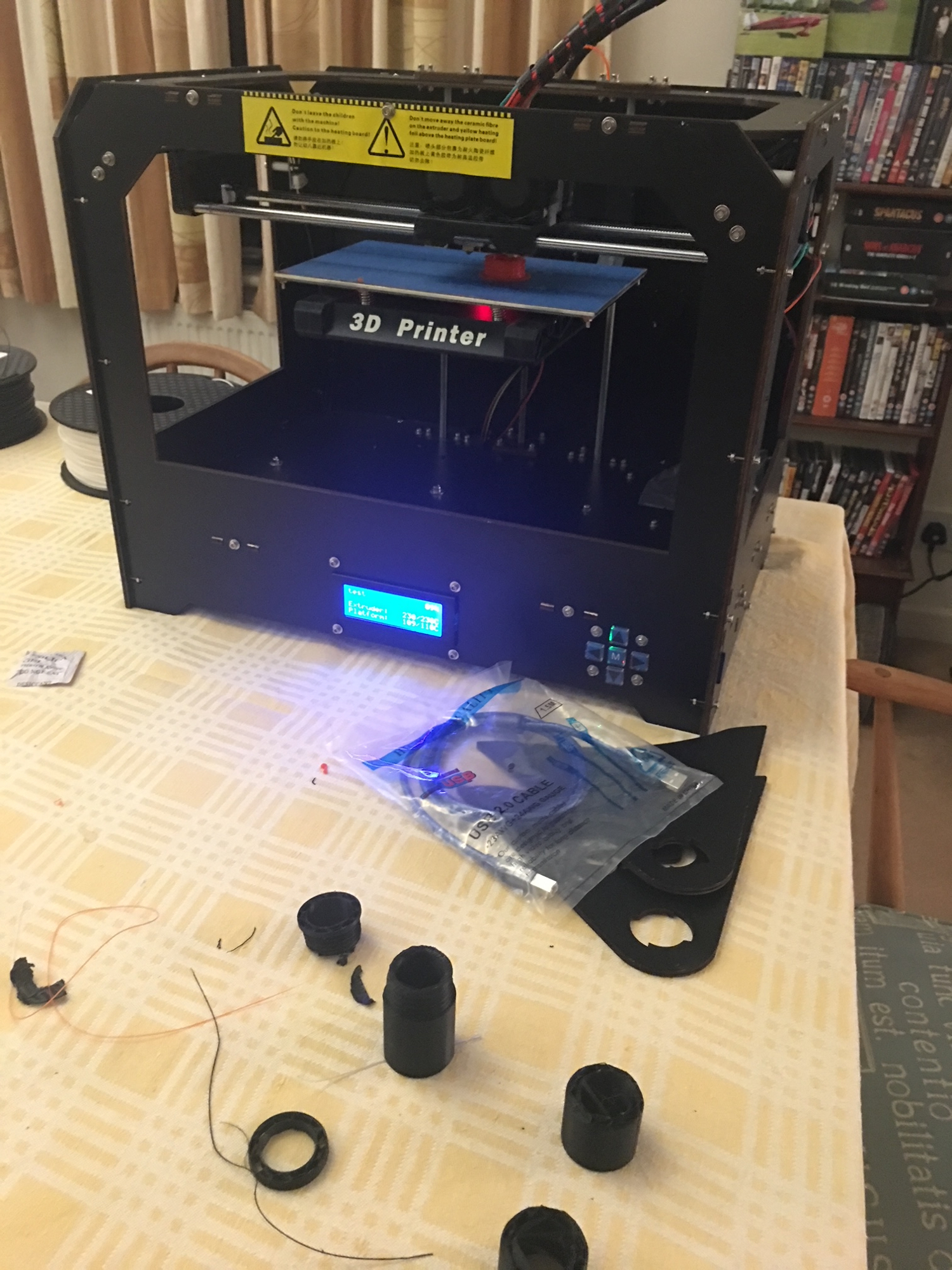
Photo by A. Howse
What 3D printer to choose for home use in the UK?
The AnkerMake website helpfully suggests considering the following aspects when choosing to buy a 3D printer for general use:
Define your needs, (identify) price range, (determine) build volume, (evaluate) print quality required and (assess) filament compatibility.
Many of the latest 3D printers are available ready to assemble like a piece of Ikea furniture or alternatively they can be pre-built and ready to ‘plug and play’ upon delivery. It is cheaper to build the 3D printer yourself, although, if you are new to this type of printer, it would definitely be worth asking a more experienced friend or professional to help guide you. This ensures you can get up and running without any off-putting teething problems. YouTube is also a good source for information and guides on 3D printing subjects.
The HotEnough.com teams’ recommendation is the Bambu Lab X1-Carbon Combo 3D Printer!
It is wonderful to have a filament station on top of this marvelous enclosed printer which gives the option to enjoy multi-colour prints with filament all neatly organized and ready to go in a specially designed printer station which sits on top of the smart looking silver 3printer cabinet.
“Bambu Lab builds state-of-the-art 3D printers that break the barriers between the digital and physical worlds, bringing creativity to a whole new level. Right now, we have three sites located at Shenzhen and Shanghai in China and Austin, Texas of U.S.” states the Bambu Lab website. (6)
The Bambu Lab X1-Carbon Combo 3D Printer won Time magazine’s ‘Best Inventions award for 2022 and we can see why. A ‘game changer’ for domestic or community 3D printing, this unit enables a fuss free system that works ‘out of the box’ and minimizes all the troubleshooting, fussing and tinkering often associated with the first generations of 3D printers for home use. (4)
The Bambu Lab X1-Carbon Combo 3D Printer is not a cheap edition to a home technology collection at around £1300 each. However, the fast and excellent quality colour printing, generally good looks and easy to use interface will enable you to enjoy and explore a world of useful and joyful pieces that can be quickly manufactured to fix and develop household items and create leisure equipment or entertain and amaze your friends.
“Bambu Lab is a consumer tech company focusing on desktop 3D printers. Starting with the X1 series, Bambu Lab builds state-of-the-art 3D printers that break the barriers between the digital and physical worlds, bringing creativity to a whole new level.” (4)
The Bambu Lab 3D printer is also surprisingly quiet and fits in a home interior without any problems. You can also watch what the printer is currently doing on your phone, tablet or PC via an Bambu app interface which allows you to direct the printer’s activities from wherever you are.
Tony Hoffman at PC Magazine independently reviewed the Original Prusa i3MK3S Plus as the best 3D printer for 2024 in his opinion. The Original Prusa i3 MK3S plus is an open framed 3D printer that comes with a user manual and is highly rated for quality with its only disadvantage being the relatively small print bed size for the price of around £800. (1)
AnkerMake manufacture 3D printers and as well as their own products they recommend Elegoo Neptune 3 Pro printer as a great choice for a quiet printer with a large printing bed size for the option of making larger pieces. (5)
What is the future of 3D printing?
To see the latest in what the 3D printing industry has developed attend the TCT 3Sixty 2024 which is promoted as the UK’s definitive industrial 3D printing and Additive Manufacturing event at the NEC in Birmingham on the 5-6th June this year. There are several inspiring talks arranged by the organisers to showcase what major companies are doing with 3D printing technology in the UK this year. (3)
Although PLA is an inert type of plastic filament and is often used for children’s toys, there are concerns about how environmentally friendly the industry is, when producing fresh items using any 3D printer system (rather than printing pieces to mend existing products we already use.)
BambuLab write that they are passionate about the “commitment to creating the next generation of eco-friendly 3D printers – pushing the industry forward toward a future with a much lower carbon-footprint.
3D printers can save energy and therefore carbon emissions by producing prints at home that meet the needs of a consumer without the need for taking a car out for a shopping trip for example.
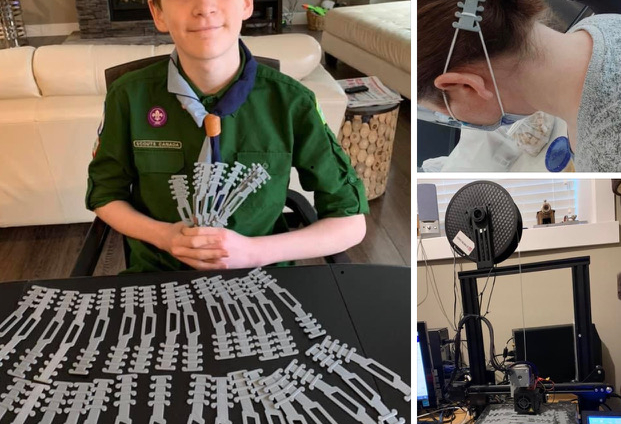
‘Scouts Do Things’ post July 2020
Over the last decade there have been many medical uses developed for 3D printers. It has been amazing to find out about the custom-made prosthetics and other medical and health support accessories, that can really help people of all ages live better lives. 3D printers were used during the covid19 lockdowns to help make protective visors and more for healthcare workers.
Many wearable technology health gadgets are made using 3D printing techniques and we predict that personalized wearable art and custom-made accessories will continue to expand into all our lives in the future.
Many talented designers have harnessed the power of colour 3D printing to create stunning figures, jewellery, sculptures and home accessories. Some 3D printed products also use other technologies such as ‘raspberry pie’ mini computers and LED lighting to explore what is possible to build using this medium.
We predict that this trend will continue to gain momentum as a generation of young people who have had access to these exciting machines within their educational experience continue to create innovative products and companies. One design limitation for producing 3D printed treasures at home is the size of the print be and the cabinet height of the printer.
Recently some advanced makers have found ways of making expanding forms (like a popular 1980’s classic toy: the slinky) interlocking sections and even weaving fabric squares that can be connected to form larger surfaces or larger objects in the same way that the famous Lego brand bricks can be used in multiple ways to form an endless number of things. So perhaps the only real limitation of using 3D printers in the future is your own imagination.
(1) ‘The Best 3D Printers for 2024’ Tony Hoffman, PC Magazine UK, 31 January 2024 ‘The Best 3D Printers for 2024’ Tony Hoffman, PC Magazine UK
(2) Original Prusa i3 MK3S plus, Prusa Research by Josef Prusa, 1 February 2024 (2) Original Prusa i3 MK3S plus, Prusa Research by Josef Prusa
(3) TCT 3Sixty 2024: Registration now open for UK’s definitive industrial 3D printing and AM event’, TCT Magazine, 14 December 2023 TCT 3Sixty 2024: Registration now open for UK’s definitive industrial 3D printing and AM event’, TCT Magazine
(4) Bambu Lab X1-Carbon Combo 3D Printer, Bambu Lab website, 8 February 2024 Bambu Lab X1-Carbon Combo 3D Printer, Bambu Lab website
(5) ‘The 10 Best Budget 3D Printers for 2023: Affordable Excellence’ AnkerMake Official website, 1 February 2024 ‘The 10 Best Budget 3D Printers for 2023: Affordable Excellence’ AnkerMake Official website
(6) ‘Bambu Lab’ About Us, official website, 8 February 2024 ‘Bambu Lab’ About Us, official website
(7) ‘Can Fusion 360 create a model for 3D printing?’ Autodesk official website, 8 February 2024 ‘Can Fusion 360 create a model for 3D printing?’ Autodesk official website
(8) ‘All you need is a ‘what if…’ Autodesk Tinkercad official website, 8 February 2024 ‘All you need is a ‘what if…’ Autodesk Tinkercad official website

